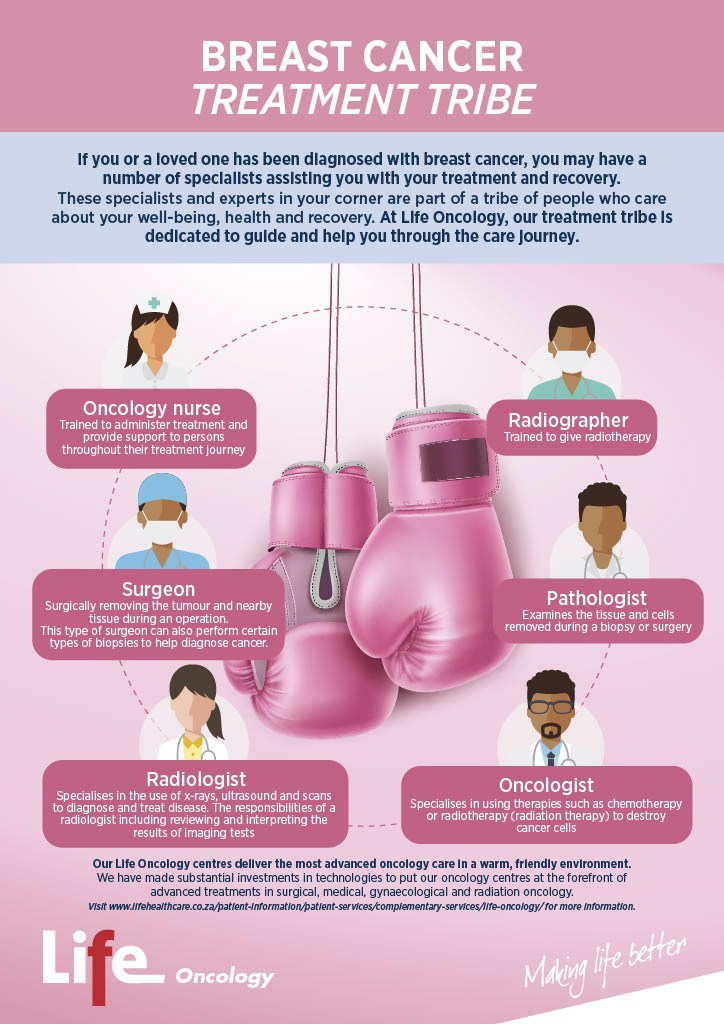Life Healthcare tackles the plight on breast cancer
Breast cancer remains the most common form of cancer among females claiming the lives of hundreds of thousands each year and affecting countries worldwide.
According to the World Health Organization, there were 15 491 new cases of breast cancer reported in South Africa last year, alone. Furthermore, a cancer diagnosis can be devastating, and the treatment journey can be overwhelming.
In response to the continually rising numbers, Life Healthcare continues to invest in medical technology and competent health-care workers, with the view to ensuring that its oncology units provide world-class comprehensive breast cancer care to patients.
“We currently have five dedicated oncology units however independent oncology practices are also located at many of our large and medium sized hospitals. Specialists also make use of our hospital oncology wards when patients undergo cancer treatments and require admission. Most of our facilities offer treatment options including surgery and mammography and our dedicated oncology units are fully equipped to assist patients throughout their treatment journeys,” says Noeleen Phillipson, Senior Manager, Life Oncology.
In addition, Life Healthcare draws on multidisciplinary teams of doctors, allied healthcare professionals and experts from different specialties who collaborate to treat breast cancer using evidence-based protocols for diagnosis and treatment.
“The multidisciplinary healthcare team, or ‘treatment tribe’ consists of a number of treatment specialists and allied healthcare professionals - each with unique expertise. We like to think of these specialists as a ‘treatment tribe’ with the core tribe including a general practitioner, surgeon, pathologist, radiologist, mammographer, oncologist and oncology nurses. In some cases, the help of dietitians, social workers, psychologists and physiotherapists is enlisted to address individual health concerns,” Noeleen explains
When diagnosed with breast cancer, the patient and her family want the best possible care with the best possible outcomes. Not only is emotional support essential, but the medical support of a treatment tribe of specialists and experts helps to bring comfort knowing the patient is in very good hands.
“Individuals diagnosed with breast cancer, or any cancer, often feel overwhelmed and fearful about the unknown. Knowing the role that each specialist has in the diagnosis and treatment of breast cancer can empower patients’ and their loved ones. Knowing who is in your treatment tribe and what their role is can be reassuring and can help in a better understanding what lies ahead,” adds Noeleen
Although Life Healthcare offers world-class treatment, early detection through regular screening remains key to treating breast cancer with better outcomes.
The good news is that nine out of 10 breast lumps are benign (non-cancerous) and are often cysts or fibroadenomas.1 However, women should know their breasts and do monthly breast-self-examinations to detect any abnormalities. A breast self-exam is a safe way to become familiar with the normal look and feel of your breasts. “Through regular self-exams, a change will be easy to recognise, and medical advice can be sought to determine if there is anything to be concerned about. These together with annual mammograms, if over the age of 50, are essential for early detection of breast cancer”, advises Noeleen
“There are a number of key symptoms that all women should be familiar with. If noticed early, and with medical consultation, early detection of the disease can significantly improve outcomes such as improved survival rates and improved quality of life”, continued Noeleen
In some cases, symptoms may go unnoticed. Medical attention is required quickly if any of the following symptoms are noticed:
- A lump or mass in the breast that feels different from the surrounding tissue
- Change is the shape, size, or appearance of the breast
- Discharge from the nipple
- Breast rash or crust formation on the skin
- Changes in the skin over the breast, for example, dimpling
- Breast pain
- Inverted or pulling-in of the nipple
- Scaling, peeling, or flaking skin over the breast, particularly the dark area around the nipple
- Redness and/or pitting of the breast skin, resembling the skin of orange
Noeleen says breast cancer is treated in several ways, depending on its kind and how advanced it has spread. Treatment options may include surgical procedures chemotherapy; hormonal therapy, biological therapy and radiation therapy or a combination of these.
“If you haven’t been doing breast-self exams or going for annual mammograms (if over 50), we encourage you to start doing so this October, which marks World Breast Cancer Awareness Month. Additionally, if you or a loved one are newly diagnosed, take time to understand who your treatment tribe which may help you overcome some of your fear and understand your treatment journey better,” Noeleen concludes.

Reference:
- Medical Review: Benign breast lumps. https://medicalreview.co.za/benign-breast-lumps/ Accessed on 2021/10/12
The information is shared on condition that readers will make their own determination, including seeking advice from a healthcare professional. E&OE. Life Healthcare Group Ltd does not accept any responsibility for any loss or damage suffered by the reader as a result of the information provided.

